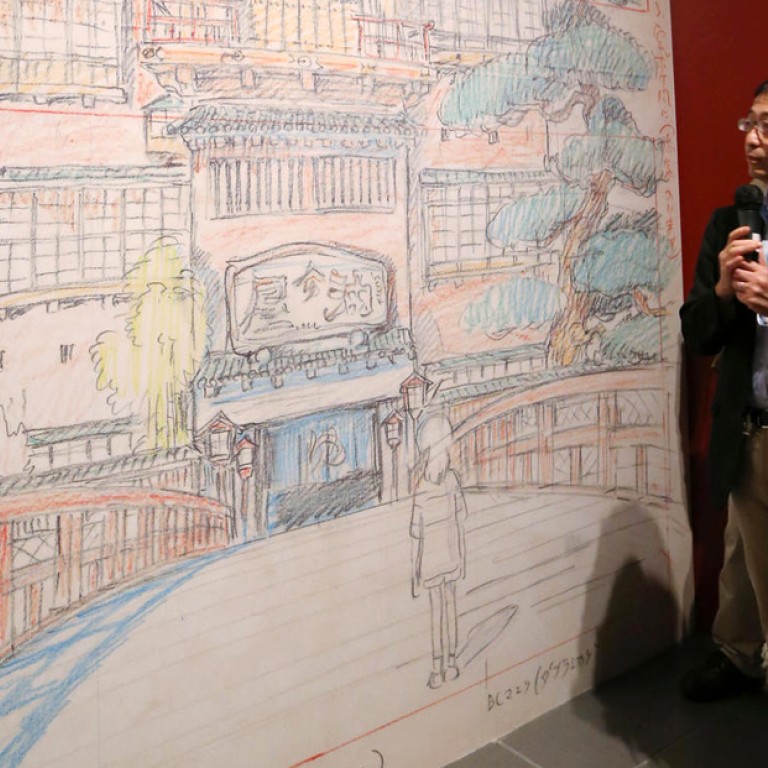
'Even Miyazaki is scared of Takahata': A peek inside the legendary Studio Ghibli
Exhibition gives insight into the contrasting styles of Hayao Miyazaki and Isao Takahata, the brains behind such works as Spirited Away
Animation powerhouse Studio Ghibli is best known for two of its directors, Hayao Miyazaki and Isao Takahata.
But the two, aged 73 and 78, are quite different from each other, says Ghibli exhibition producer Kazuyoshi Tanaka, in Hong Kong for an exhibition of the studio’s work.
“Miyazaki does everything on time. He takes out a lunchbox at a specific time and sleeps regular hours,” Tanaka said.
“Takahata has a freer lifestyle. If we didn’t call him up, he could disappear until sunset. We need to send staff members to pick him up … he forgets about time and place when he is in deep thought.”
Takahata is meticulous in his work, and never compromises quality in the face of deadlines, said Tanaka. “Even Miyazaki is scared of him.”

The pair, who co-founded the Tokyo studio in 1985, have directed its most renowned animated films. Miyazi was behind My Neighbor Totoro, Ponyo, The Wind Rises and the Oscar-winning Spirited Away. He received a Golden Lion from the Venice Film Festival for lifetime achievement in 2005.
Takahata helmed favourites such as Grave of the Fireflies, Pom Poko and the studio’s latest release, The Tale of Princess Kaguya.
As directors, both had to draw many animation layouts when designing scenes. The layouts, drawn in pencil, describe movements of cameras and characters as well as how backgrounds should look.
They are the most important references for a team of animators and background artists who draw the characters and backgrounds in detail afterwards.
Back in 1974, Takahata and Miyazaki created the layout system to increase efficiency and consistency of quality in the making of anime.
“Miyazaki drew 300 layouts in a week for the making of [anime series] Heidi, Girl of the Alps. He was 33,” Tanaka recalled, adding that the director did not return home for the whole week.

Each animated film requires about 1,200 layouts, but the number could reach 6,000 for specific works. The director draws the most important scenes.
Miyazaki drew the opening scene of Nausicaa of the Valley of the Wind. He also drew 70 per cent of the layouts in Spirited Away.
Given Miyazaki’s unique ideas on how to present scenes, coupled with his prodigious drawing talent, animators in the studio sometimes worry about their works being completely changed or dumped by the mastermind, said Tanaka.
Takahata, whose drawing style was imitated by Miyazaki in his early days, loves realism. He is loved by animators for his detailed suggestions, which go as far as the types of plants that should be drawn in the background.
Upon release of The Wind Rises last year, Miyazaki said he would retire. Although he also “retired” after finishing Princess Mononoke in 1997, only to return with Spirited Away, Miyazaki has told studio members he really means it this time.
What he has left is a legacy of fantastical creatures, strong female characters, and clear environmentalist and anti-war themes – especially in his last film.
“He loves food, nature, paintings and fighter jets,” Kan Miyoshi, curator of the Ghibli Museum in Tokyo, said. “Although he has always been anti-war, he loves fighter jets and draws them a lot. It’s a strange contrast.”
The Studio Ghibli Layout Designs exhibition runs from today until the end of August at the Heritage Museum in Sha Tin. It showcases some 1,300 layouts from more than 30 of the studio's animated works. There is a photo-taking area allowing visitors to lie on the character Totoro's stomach or hold a bucket in which Ponyo is swimming.

